Northwest Chicago Senior Care Comes of Age
From Working to Preserve Our Heritage: The Incredible Legacy of Greek-American Community Services
"The staff and volunteers worked hard to establish a routine for the center and its operations. Amydelle, as the center’s supervisor, Dr. Kioutas, and I created the policies and procedures for the center with the gracious help of other adult day care centers. Jane Stansell provided a copy of her center’s policy book as a reference. The policies were detailed and comprehensive and covered an array of topics such as medication storage and administration procedures, notes, logs and charts, supplies lists, and emergency preparation. We arranged for regular fire drills, CPR training and TB testing, and ongoing professional development for staff and volunteers.
The center developed procedures related to food service. These included: proper food handling and food temperature controls, inventory lists for supplies, and planned menu cycles for each quarter of the year with portion sizes that were approved by a registered dietician. At Alvernia Place, Search Developmental, a day program for the developmentally disabled located on the second floor, prepared our meals onsite in the former high school’s kitchen. Once GACS moved to Pulaski, we determined that the amount of money needed to install a full kitchen with venting and up-to-code was beyond our budget. Add in the cost of food and utensils, a paid cook, and the expense of preparing meals on-site seemed prohibitive. Instead, we arranged for catering and utilized the kitchen area to prepare and serve the meals and snacks that were delivered daily. We intended to add the kitchen later.
For the first few years, GACS contracted with Plum Catering which handled food service for childcare centers. They wanted to break into the adult day care segment and offered a discounted price to use us as a reference. After a noticeable decline in food quality and a price increase, we switched to Open Kitchens, which at the time supplied the majority of meals provided to seniors through the city’s Meals on Wheels program, as well as many of the Golden Diner’s sites. The meals were of a higher quality than before and the price was a bit less due to the larger scale of meals they prepared daily. Each morning, we received a delivery of lunch and two snacks. We separately purchased milk, usually donated by Tessie Cantos, which was required to be served whether or not the client wanted it, as well as toast, cereal, oatmeal, muffins, or bagels for the morning snack, decaffeinated coffee, and other incidentals.
At least monthly, participants went out for lunch, and during the warmer months, boxed lunches were prepared for visits to the lakefront or nearby Independence Park. Whenever possible the center served lunches donated by Greek-owned restaurants and food purveyors including the Harris, Greek Islands, Little Mike’s, Pegasus, and Roditys restaurants, Master Caterers, and others. Through the efforts of Eleni Bousis, Goya Foods executives donated and served the fixings of a great freshly prepared lunch on a few occasions.
The nurse on duty interacted daily with each participant to assess their conditions, dispense medications, assist clients in the bathroom, and monitor their overall health. She communicated with the participant’s family and physician as needed and participated in the initial intake process. When the supervisor wasn’t there, the nurse on duty was designated the acting supervisor. The position at one time or another was filled by Fran Argiris, Amydelle Shah, Eileen Casey, Eleanor Huber, Lorraine Lisowski, and Linda Mirza. All were registered nurses (RNs).
The social worker handled outreach and coordinated the intake process. She was the primary point of contact for the families and provided one-to-one or small-group assistance as needed. The social worker coordinated the ADC’s family support group and arranged for the transportation of the participants. Ethel Kotsovos and Despina Massouras held this position. When Amydelle stepped down from the supervisor role, she remained a rotating nurse and stepped in as an intake worker when the social worker wasn’t available.
Ann Prusinski was the activity director of the center throughout its existence. Ann planned and coordinated a monthly calendar of activities and supervised the activity aides and volunteers who helped. The activities included everyday routine tasks like reality orientation, current events, weekly movies, and a monthly outing. They held monthly participant council meetings in which the clients discussed center matters, determined where they wanted to go on their monthly field trip and participated in planning the month’s activity calendar. The supervisor, social worker, and nurse on duty also attended.
The intake process began with the social worker who met the potential participant and their primary caregiver(s). An intake packet was initiated, which included an assessment of their ability to accomplish activities of daily living, psychosocial assessments, and general information on the clients and their preferences, dietary restrictions, hobbies and interests, emergency contacts, etc. The nurse completed a health assessment, and a medical form was faxed to their doctor who listed any medications that might need to be taken at the center and provided authorization for her to dispense these medicines. Clients were asked to bring an extra change of clothing which was kept at the center in case it was ever needed. We also took a face picture of each client which was affixed to the inside front cover of the client’s chart.
A typical day at Northwest Chicago Senior Care began at 7 a.m. when Ray and the drivers would meet with Ann to go over the route list and make any last-minute changes. By 7:15 a.m., the vans departed on their routes. One route usually went north and west of the center while the second went south and east. Ray accompanied whichever route had the most clients on a particular day. While Ann made coffee, the activity aides arrived as families began to drop off participants on their way to work.
The team prepared morning snacks for those who had arrived. Sometimes it was decaffeinated coffee and toast, bagels, or English muffins accompanied by a piece of fruit. Other times it was cereal or oatmeal. The morning news was on television in the background so clients could watch the news or socialize as the day got started. The nurse dispensed the medications for the day into medicine cups labeled with the participant’s name and the name and dosage of the medicine. The social worker was the point of contact with families and communicated with family members, case managers, and others regarding any participant concerns.
Once the morning snacks were served, there was a current events session where Ann read through the day’s newspaper with the participants and encouraged conversation about the topics of the day, followed by the gossip and advice columns, and the day’s horoscopes. Next was an exercise class in which participants were encouraged to participate to the extent possible. The sessions included stretching, bending, chair aerobics, and walking around the center to music. During nice weather, participants exercised on the patio or took outdoor walks.
While the exercise class was occurring, Ray, sometimes with the assistance of clients that wanted to help, arranged and set the tables and chairs, filled water glasses, and placed the napkins and utensils. At 11:00 a.m., as participants were seated for lunch, an assembly line of staff plated and served the meals.
Food temperatures were taken and recorded to confirm it was safe to serve. The food came fully cooked in large trays and was transported in insulated containers designed to retain proper food temperatures from the time of delivery, which was earlier in the morning, until serving. The nurse monitored the process to ensure portion sizes were correct and participants that were on special diets didn’t get something that was not allowed. Once everyone was served, the staff joined the clients at lunch. It was a time when we all came together as a group. The WGN-TV midday news played in the background and once participants finished eating, they moved to the living room area to watch the news and wait for the others to finish and for medications to be administered.
At 12:45 p.m., the first afternoon activity began, usually followed by a second activity around 1:30 p.m. and ending at 2:45 p.m. Depending on the day of the week and the week in the month, the activities varied but included: music, art, bingo, intergenerational activities, pet therapy, men’s group, classic movies, arts and crafts, games, looming, bowling, trips to the park, special interest groups and outside visitors. On Wednesdays, those who were interested joined the Fabric Arts Program classes. At 2:15 p.m., the afternoon snack was served, usually fruit of some sort, or fruit juice and another type of snack. On movie days, popcorn was served. On other days, wheat crackers with cheese or granola and yogurt were offered. The café room was available for clients to visit, and music was played in the background. The library room also functioned as a quiet area that provided a place of retreat for participants. The arts and crafts room was open to participants when it wasn’t being used for a class.
At about 3:00 p.m. participants began to board the Ya’Sou vans for their rides home. Those who were picked up by family members remained behind until their rides arrived. While waiting, clients, often joined by Tornie, enjoyed watching the Wheel of Fortune and Jeopardy television game shows. While that was happening, staff completed their charting, filled out paperwork, and prepared for the next day.
The participants were excited when a donation of a Video Cassette Recorder (VCR) was received. It expanded programming possibilities. Each week, Phil Williams, an ADC volunteer, and classic movie buff brought in a video from his vast collection of classic movies to share with the clients. He also showed recordings of television programs featuring Bob Hope, Lucille Ball, Jack Benny, Milton Berle, Burns and Allen, Roy Rogers and Dale Evans, and others. Phil video-recorded several GACS events and parties with his camcorder. In time, through donations, we were able to amass an impressive video library of our own.
A monthly birthday party was held for those who celebrated during that month. Family members of the celebrants were invited to the party which usually involved cake and ice cream. During the summer months, we sometimes ordered boxed lunches and went to the lakefront, Independence Park, or other venues for a picnic lunch. We also held cookouts where we grilled hot dogs or hamburgers, corn, etc. on our rear patio.
The vans made it possible for ADC clients to go on at least one field trip per month. Participants discussed and voted on where they wanted to go. The trips usually involved going to lunch at places like Big Top, Buffalo Bills, Dapper’s, Grecian Taverna, Harris, Jeff’s Red Hots, Little Mike’s, Margie’s Candies, Mr. K’s, Mykonos, Old Country Buffet, Pizza Hut, Zephyr’s Ice Cream Parlor, and restaurants in Greektown. Participants visited Brookfield Zoo, Chicago Botanic Gardens, Chicago Cubs baseball games, Hellenic Museum and Cultural Center, and Lincoln Park Zoo, and went to Mayor Daley’s Senior Citizens Picnics and a taping of the Jenny Jones Show at NBC Tower.
Each year, the ADC arranged two outings to Chicago Cubs games at Wrigley Field. One was for any clients who wanted and were able to go. The second was an outing for the men’s group led by Bob and Ray. In November, participants attended a Thanksgiving luncheon cruise on Lake Michigan aboard the Odyssey. In December, a shopping trip to the Harlem and Irving Plaza was arranged so that participants could shop for Christmas gifts for family members. Afterward, they went for lunch at Pizza Hut across the street. Whenever possible, family members were invited to join the trips.
Throughout the day participants were tended to medically as necessary. This included assisting them in the bathroom, dispensing medicines, checking vitals and blood sugar levels, and one-to-one visits with the nurse or social worker to discuss matters of concern to the participant or family.
Visits to the center included performances from the Sweet Adelines, a senior citizen’s women’s singing group, the Lincoln Park Zoo Traveling Zoo, Tree House Animal Shelter, and a group that reenacted classic radio programs. Periodically, residents of the Norwood Park Home Kitchen Band, led by their administrator, visited and performed. This led to the creation of a kitchen band that practiced regularly and was invited to perform at Norwood Park Home. Special guests who visited the center included U.S. Senator Paul Simon; Congressmen Dan Rostenkowski, Michael Flanagan, Frank Annunzio, Sydney Yates, and Rod Blagojevich; State Senator John Cullerton; TV personality Norman Ross, and others. On his visits, Annunzio brought a box of his trademark shopping bags swag for the clients. Mike Bakalis filmed a commercial in the center during his campaign for governor.
One year, a number of the more active participants took part in the experimental Liz Lerman Dance Exchange in partnership with the Columbia School of Dance. Each week, several participants took part in dance and movement classes for seniors led by dance students. John drove the participants to the gatherings which were held at Lawrence House Retirement House and the Columbia School of Dance. We also hosted a few of the classes at GACS. The project culminated in three public performances that John and a few of the clients took part in. I recall attending one performance and was amazed at what our clients achieved.
Intergenerational programming was a priority, and participants interacted with children in a variety of ways. This included visits from Plato and Socrates schools where children would sing for the participants, work on art projects or play games with participants. ADC clients prepared and shared popcorn with the young visitors. Visits from children in the Kid-Watch program at Alvernia Place were regular occurrences. After we moved to Pulaski that relationship continued with the children visiting our seniors and working on art projects together. During the summer months, they gathered halfway between the centers at Independence Park.
An ADC monthly caregivers support group co-led by the nurse and social worker was available to families and caregivers. A family council was created and grew to include many of the center’s families. The council supported our dinner dances, and they launched an annual rummage sale that was held at the center.
A newsletter was produced by center participants under the guidance of Amydelle Shah, who in addition to nursing, wrote a monthly column in Prime Times, and had done other writing as well. A May 1997 newsletter featured remembrances of Casimer “Casey” Misiewicz, a long-time participant, who was popular with clients and staff. It included articles written and edited by center participants. Among the topics in this issue were “Memories of Christmas ‘1996,’” reports, discussion group topics, field trip plans, and announcements about new clients and those who had recently left the center.
A genuine sense of community existed within the center. Higher functioning clients looked after those who required more assistance or orientation. Participants became friends with each other and often talked by phone or sometimes visited each other on their own time. Family members got to know each other while picking up their loved ones or through the family support group. If a client became ill or was in the hospital, staff and clients would call or visit. When a death occurred, it was not uncommon for participants to attend the wake or funeral.
Between October 1, 1992 – March 30, 1993, The ADC received 45 inquiries and completed 15 intakes. There were 13 admissions and 4 closed cases. There were 24 enrolled participants with an average daily census of 17.
An interim report to the Retirement Research Foundation covering the period October 1, 1994 – March 31, 1995, provided updated statistics. There were 46 inquiries, 15 intakes, 12 admissions, eight closed cases, and six support group meetings. There were 36 enrolled participants with an average daily census of 21.
By April 1995, ADC enrollment had grown to 37 and the average daily census had grown to 24. Wednesdays were the busiest day of the week with an average census of 28 and Thursdays were the least busy with a census of 12. Monthly billings had risen from $2,407 in July 1992 to $11,903 in March 1995. At the time GACS was receiving $24.65 per client/per day for CCP clients while the actual cost of care was $45 per client/day. Grants and fundraising made up the difference.
On May 1, GACS submitted a $91,000 grant request to the Retirement Research Foundation for three more years of funding for the adult day care center. The grant, which was approved, supported continued outreach efforts and the social worker position. The proposal included two letters in support of the request addressed to Marilyn Hennessy, president of the RRF, from Luke C. Fitzgerald, Northwest Regional Director of the Chicago Department on Aging, and Rosemary Gemperle, executive director of CLESE.
In her letter, dated April 20, 1995, Rosemary wrote:
'This letter is to support the efforts of the Greek-American Community Services in serving the elderly through their Adult Day Care program. I have worked closely with John Psiharis for many years and have seen the Day Care program expand from 8 clients to 38: from 3 days a week to 5: from no vans to 2 vans (and now a need for a third). And, as you probably know, they now own the building.
John and his staff at GACS seem tireless in their continuous efforts (and success) at tapping into the resources of the Greek community – both for their Adult Day Care program and the forthcoming nursing home. GACS has also used those resources to benefit CLESE, by obtaining volunteer entertainers and restaurants for our fundraisers.
The Greek-American Community Services’ generosity extends to other ethnic agencies serving the elderly. They have provided consultation to agencies considering establishing Adult Day Care programs, and they continue to give assistance to a Korean Adult Day Care program that opened two years ago. The commitment of the Greek community to GACS, and the dedication and benevolence of GACS staff and volunteers make the agency viable and worthy.
I am happy to support them and encourage your positive consideration of their request.'
Another letter of support from Rosemary read:
'I have worked closely with John since 1987 when he represented the Greek community in an ethnic elderly needs assessment that I coordinated for the Chicago Department on Aging. Subsequently, with the incorporation of the Coalition of Limited English Speaking Elderly, John became a Director of the Board and has served the Coalition either as a Board member or committee member since 1989.
I came to rely upon John as the person on the Board who knew the most about how a not-for-profit should run. He is knowledgeable about administrative, legal, legislative, and fundraising issues. Because of his competence and the trust they had in him, the Board of Directors selected John to serve as president two times, He is the only individual to have served twice.
John has a friendly but serious demeanor that encourages the kind of respect you’d like to see in a leader. I have seen in John a tenacious commitment to whatever organization, campaign, or fundraising event he’s involved with. His sensitivity to older people and his grasp of the inner workings of an organization are reasons I encourage your serious consideration of this application.'"
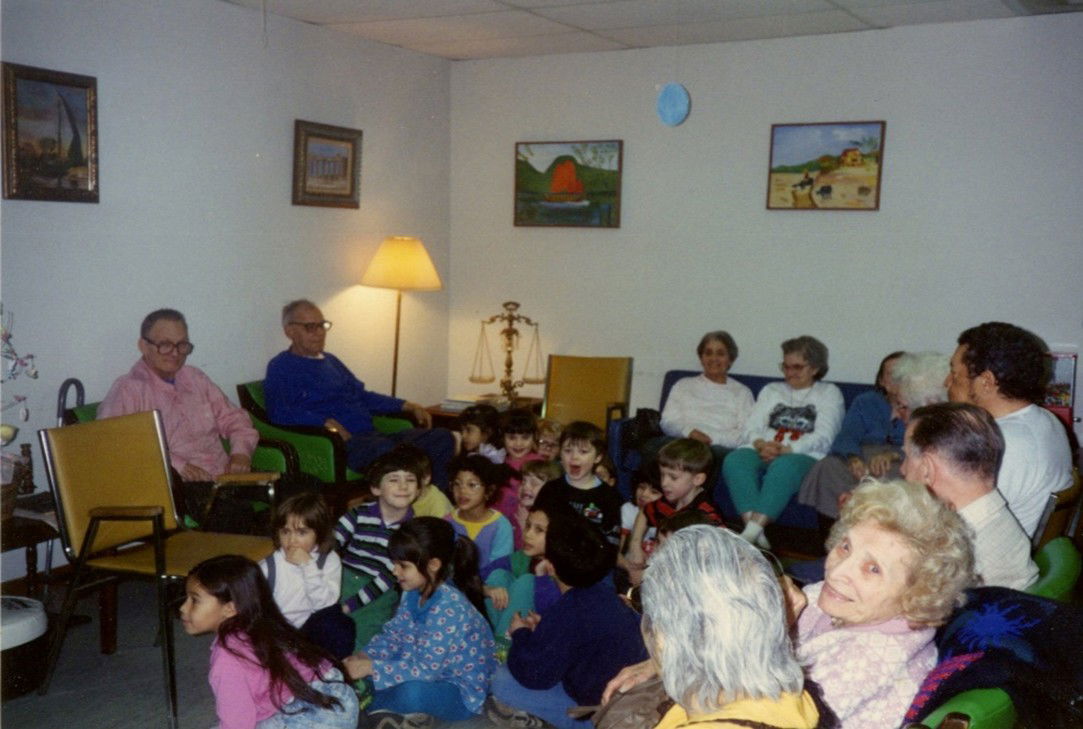
Children visiting with ADC participants. The artwork on the walls were painted and donated by Amydelle Shah and was based on her travels. Date unknown. John Psiharis collection.
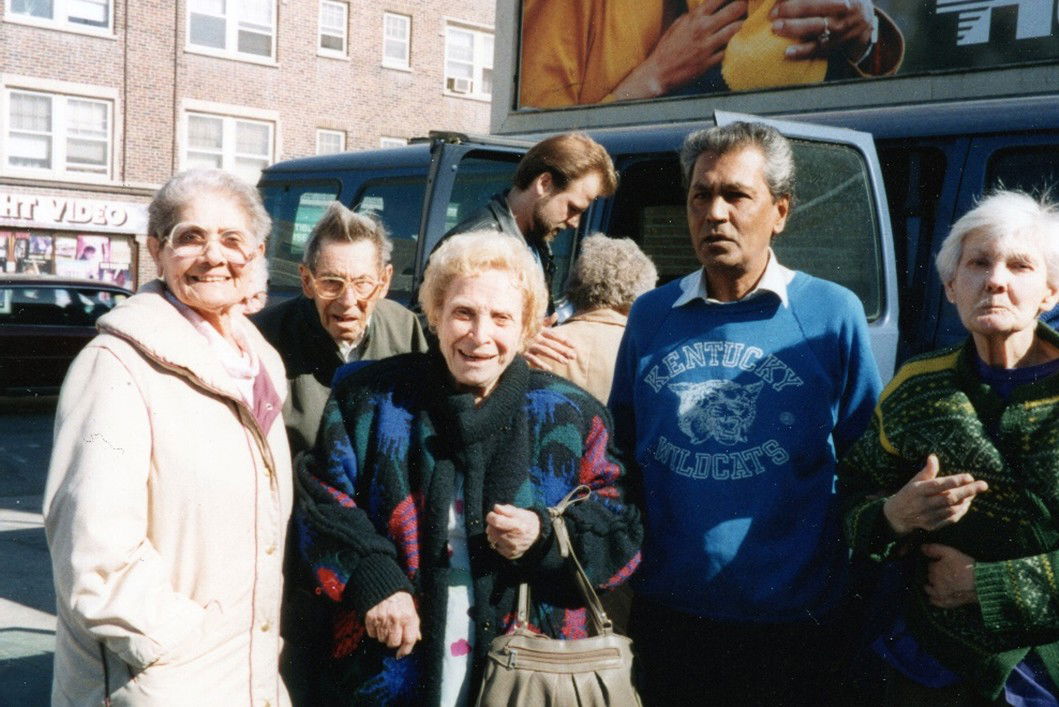
ADC participants are boarded onto the Ya’Sou vans for their trip home with Ray Manasingh and Bob Blum (in the background). Date unknown, John Psiharis collection.
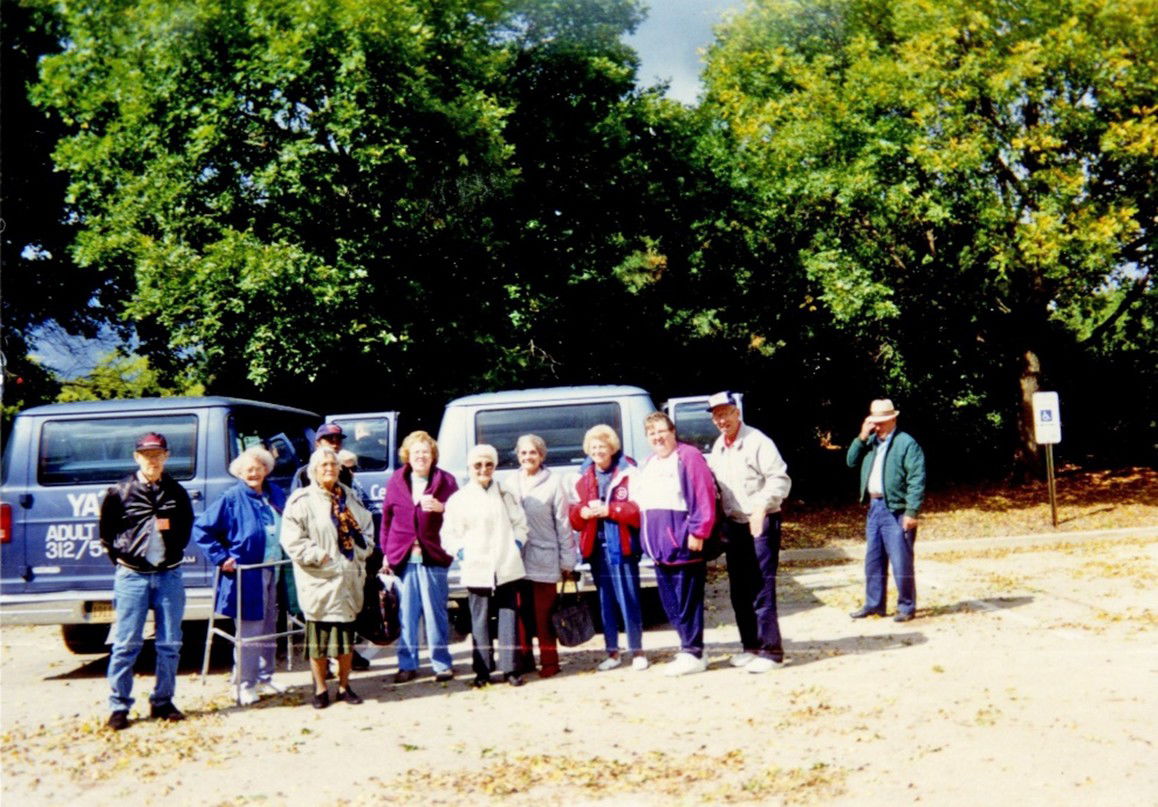
ADC clients exit the Ya’Sou vans and gather for a picture during a trip to the Chicago Botanical Gardens. Date unknown. Photo courtesy of the National Hellenic Museum - Ann Prusinski collection.
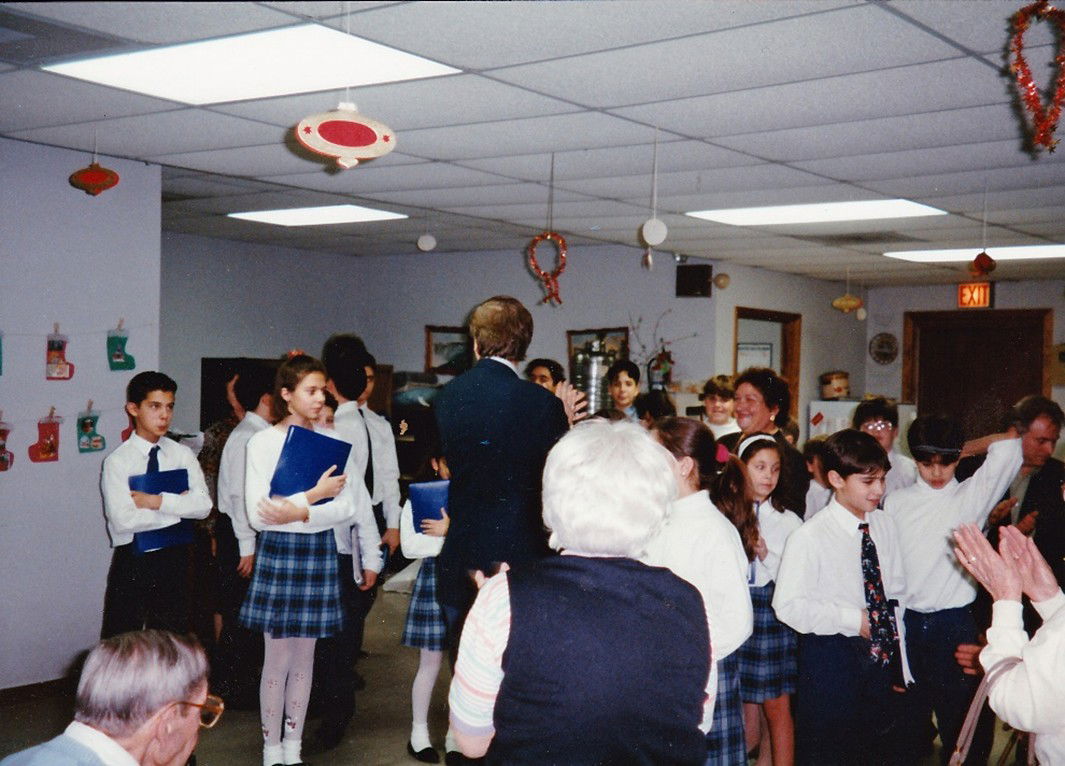
Plato Academy children perform during a GACS Christmas party. Date unknown. John Psiharis collection.
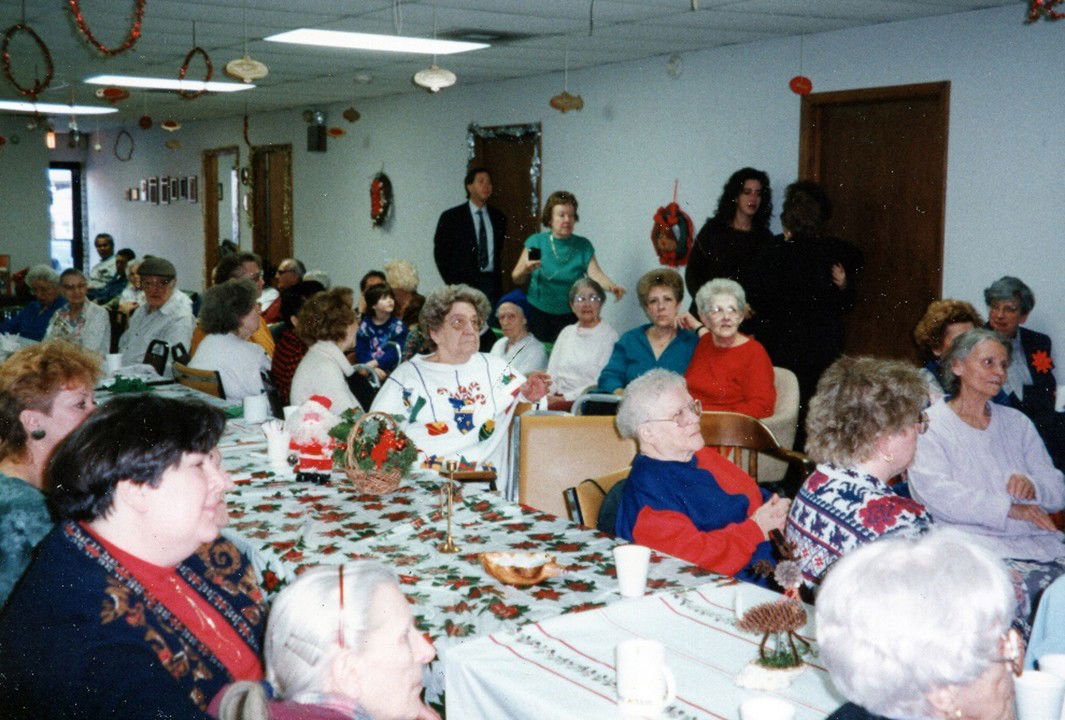
A GACS Christmas party. Date unknown. John Psiharis collection.
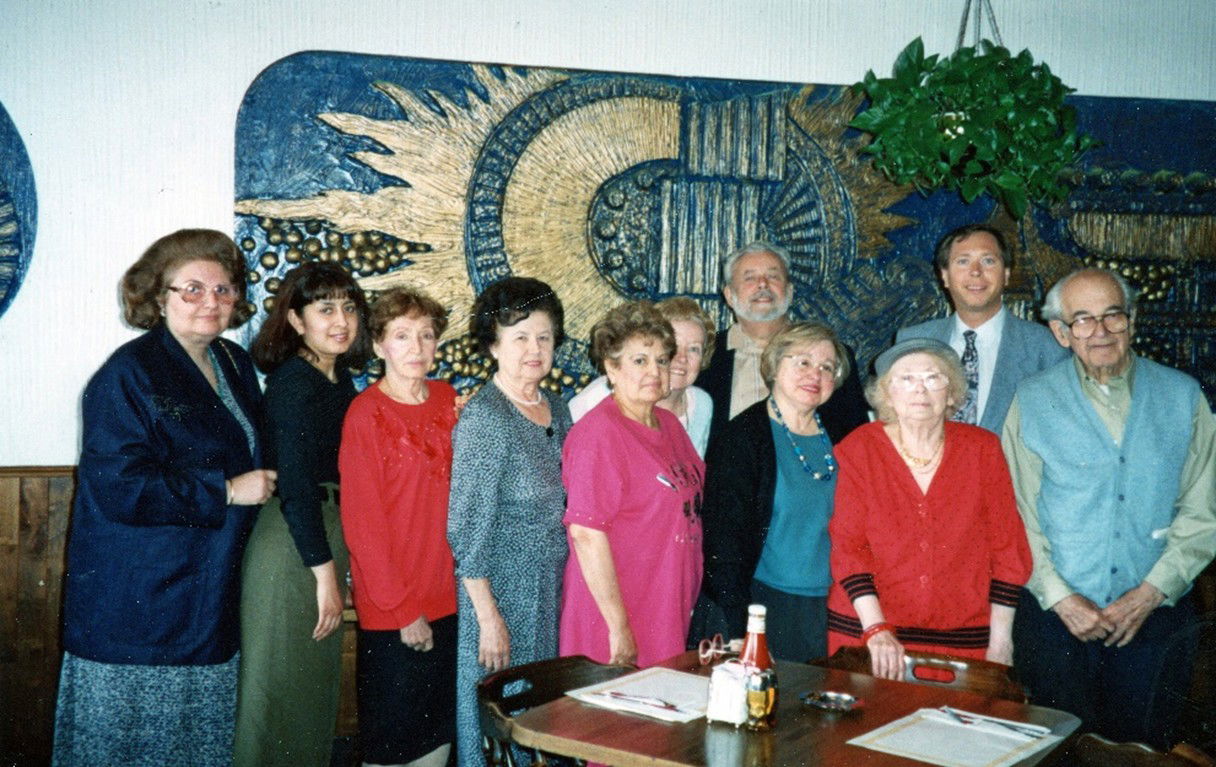
GACS staff and volunteers at a Volunteer Luncheon held at Central Gyros. Pictured (L-R): Despina Massouras, Maria Toledo, Carmen Vilato, Frieda Aravosis, Toni Panos, Ann Prusinski, Phil Williams, Evangeline Mistaras, Amydelle Shah, John Psiharis, and Alex Cantos. Circa 1994 or 1995. Photo by John Rassogianis. John Psiharis collection.
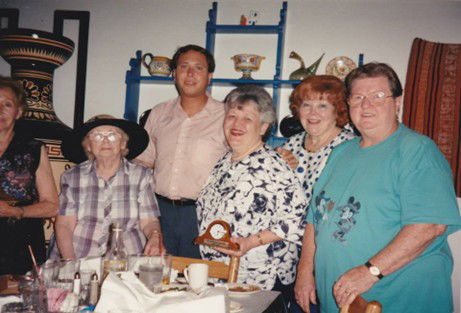
John Psiharis with the ADC nurses. Pictured (L-R): Carmen Vilato, Amydelle Shah, John Psiharis, Eileen Casey, Eleanor Huber, and Kathleen O’Leary, at a volunteer dinner, during which, Carmen and Eileen received the Executive Director’s Awards. Date unknown. John Psiharis collection.